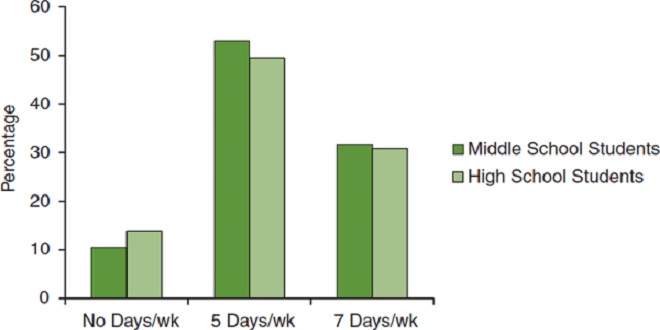Status and Trends of Physical Activity Behaviors and Related School Policies

Physical Activity
Unless they take a nap or lie down to rest, all people are physically active from when they get up in the morning until they go to bed at night. Physical activity is a necessary part of everything people do at home, work, or school while going from place to place and during leisure time. Few people in the United States, whether adults or children, expend a great deal of energy during physical activity, but they are constantly spending some. In the still-emerging field of physical activity and public health, physical activity is commonly defined as “any bodily movement produced by skeletal muscles that result in energy expenditure.” Despite this straightforward definition, physical activity is a complex behavior with various types and intensities. Types of physical activity may be categorized, for example, by type of movement, by sport, by life context, or by predominant physiologic effect. Regardless of the categorization scheme, physical activity operates through multiple physiologic pathways to influence many health outcomes. Although physical activity can be categorized and discussed in many ways, aerobic activities are the most common and have the broadest physiologic and health effects.
Status of physical activity behaviors AMONG YOUTH
This section reviews what is known about the status of physical activity behaviors among youth, first for vigorous- or moderate-intensity activity, next for sedentary or light-intensity activity, and finally for hearty- or moderate-intensity activity during the school day.
Dose of Physical Activity
The dose of physical activity, sometimes referred to as volume or amount, is a function of the action’s type, frequency, duration, and intensity. Until recently, benefits appeared to derive almost exclusively from vigorous- or moderate-intensity physical activity, and nearly all epidemiologic, clinical, and intervention research focused on that intensity range. Evidence derived from that research indicated that, for both adults and youth, health benefits are more closely related to the total dose of vigorous- or moderate-intensity physical activity than to any of the components of amount (i.e., type, frequency, duration, intensity) (PAGAC, 2008). In addition, research has consistently demonstrated an inverse relationship between the dose of regular vigorous- or moderate-intensity physical activity and various adverse health outcomes.
Sedentary or Light-Intensity Physical Activity
Recent evidence indicates that light-intensity physical activity, although not likely a substitute for vigorous- or moderate-intensity physical activity, is beneficial to health. Research has focused on the detrimental health impact of sedentary-intensity physical activity, usually sitting or watching television, but the evidence can just as well be described as showing benefits from light-intensity physical activity. The relative merits of different levels and combinations of physical activity intensities are being investigated and discussed. Still, the lower end of the spectrum of the rate of energy expenditure is now receiving attention previously reserved for the higher end.
Vigorous- or Moderate-Intensity Physical Activity during the School Day
In the United States, elementary and secondary school students spend 180 days every year. On those days, about 6.5 hours, or about 40 percent of their waking hours, make up the official school day. Including time spent going to and from school and in school-related after-school activities, students spend half or more of the available hours of every school day at school or going to and from school. Given the large proportion of total waking hours spent at school and in school-related activities, remarkably little is known about students’ physical activity behaviors during school hours and school-related after-school activities.
Classroom Physical Activity
Information is insufficient to estimate the amount of vigorous- or moderate-intensity physical activity in which an average student engages during usual instructional classroom time. However, as noted earlier, it is estimated that classroom physical activity could add 19 minutes of such action to every school day (Bassett et al., 2013), perhaps at the primary and secondary school levels.
Summary
Despite the growing popularity of these after-school activities, no reasonable estimates of the number of participants exist. However, as noted earlier, after-school activity programs for elementary and middle school students are estimated to add 10 minutes per day of vigorous- or moderate-intensity physical activity.





